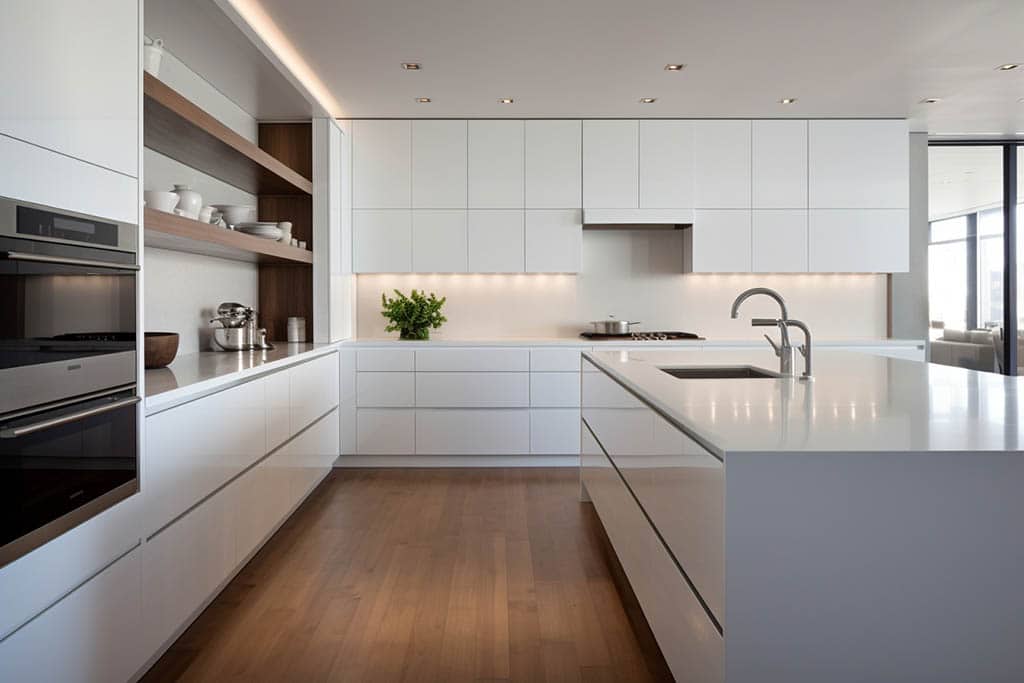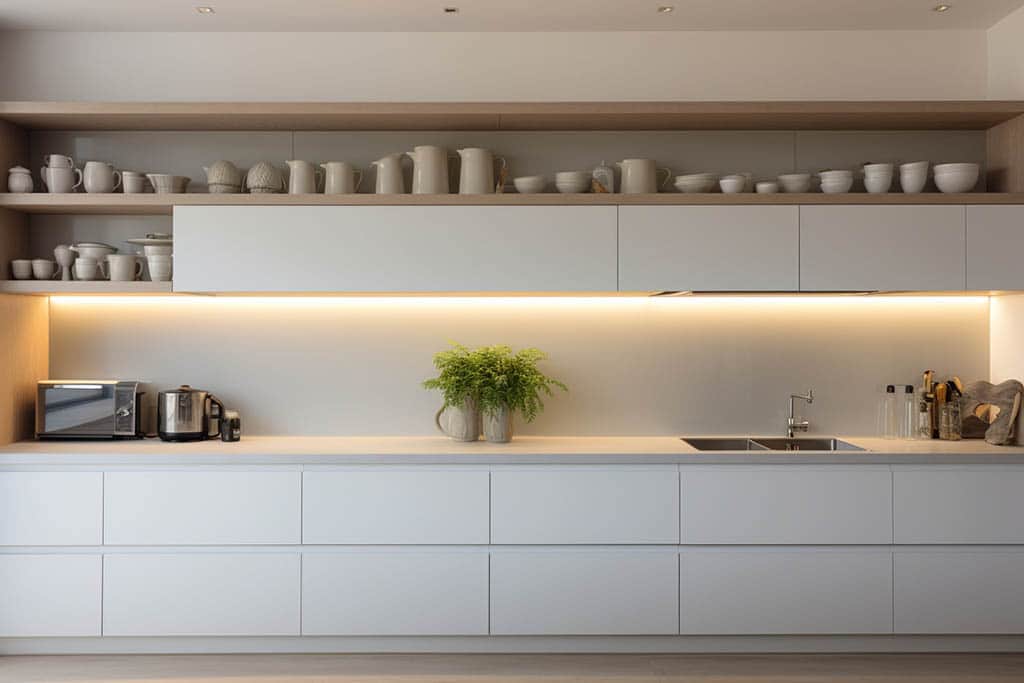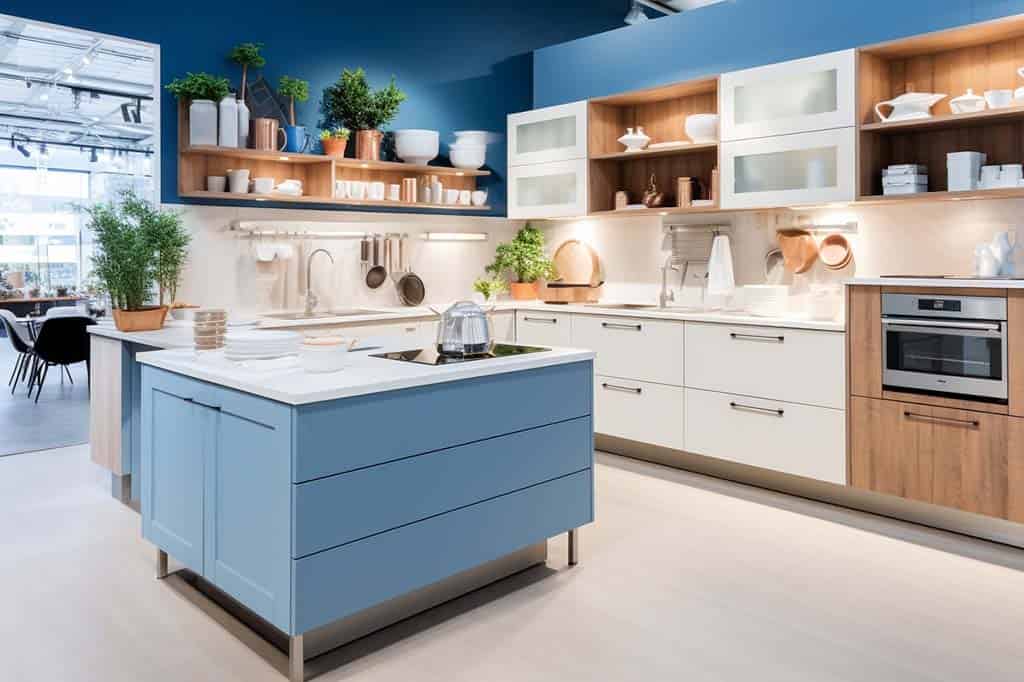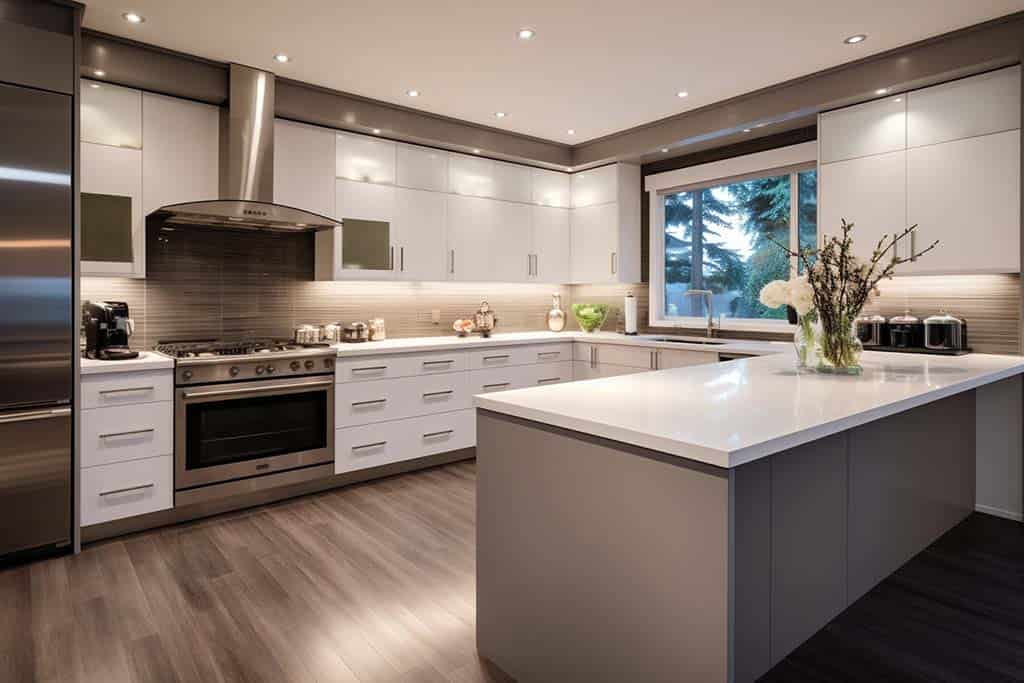
Kitchen wall-hung cabinets include any units that are mounted on a wall and raised above the ground. Strategically mounted on the wall and raised above the ground, overhead kitchen cabinets are very practical, storing items at eye level. When it comes to kitchen upper cabinet design, the possibilities are boundless.
This comprehensive guide dives into the diverse world of wall cabinet for kitchen options, unravelling the possibilities for both style and functionality. From the basics of installation to the myriad design options available, we explore how they can transform your cooking space. Whether you’re seeking to maximize storage, elevate your kitchen’s visual appeal, or strike the perfect balance between form and function, join us on a journey through the nuanced realm of a kitchen with upper cabinets.
Adding top cabinets in the kitchen benefits
The practice of hanging wall kitchen cabinets comes laden with advantages that transform the kitchen space greatly in terms of functionality and design. Let’s see how attaching kitchen cabinets to a wall can elevate your kitchen experience:
-
- Hanging cabinets unlocks valuable room in your kitchen. By making use of vertical space, you create additional storage opportunities, minimizing clutter on countertops and providing a designated spot for kitchen essentials.
- Compared with the kitchen with no wall cabinets, a kitchen outfitted with cupboard wall unit storage offers unparalleled accessibility. Frequently used items are conveniently stored at eye level, reducing the need to bend or stretch to access essentials.
- Incorporating lighting on the underside of kitchen wall cabinets serves a practical purpose. An overhead kitchen cupboard illumination significantly improves visibility in your workspace. Proper worktop lighting is highly important, making meal preparation and cooking a more enjoyable and safe experience.
- Kitchen cupboard wall units contribute to a sleek and organized aesthetic. Multiple layouts and overhead kitchen cabinet door styles allow you to tune kitchen design with your preferences, from traditional to ultra-modern.
- The uncluttered kitchen surfaces provide a clean look and facilitate easy cleaning. With plenty of hanging wall kitchen cabinets, your countertops are free of buildups, eliminating dust and grime accumulation.
The decision to incorporate kitchen top cabinets is a strategic move towards a more organized, efficient, and visually appealing space. Whether you’re maximizing storage or enhancing the overall aesthetics, wall-hung kitchen cabinets prove to be a worthy investment, in the way you interact with your kitchen.
The role of wall cupboards in kitchen design
Wall-mounted kitchen cabinets are often specified for kitchen design. Moreover, uppers are the most flexible in terms of design. Upper kitchen cabinets offer an array of options for heights, widths, depths, and door styles. This flexibility allows homeowners and designers to customize their kitchen spaces according to both practical needs and stylistic preferences.
While the base kitchen cabinets support the countertops and provide a variety of storage options, the wall cabinets take on the majority of looks. Top kitchen cabinets are most visible during remodelling and are most important, shaping the overall aesthetic and practicality of the cooking space.
In kitchen aesthetics, wall-hung kitchen cabinets take centre stage. Overhead cabinet design, whether contemporary or traditional, shapes the visual identity of the kitchen. From modern kitchen overhead cabinets to farmhouse-inspired designs, the choices are extensive, allowing for seamless integration with diverse interior styles and colours.
The evolution of kitchen wall cupboard designs has given rise to a plethora of creative ideas. From contrasting styles like kitchen cabinets with dark top and light bottom to embracing the charm of farmhouse kitchen wall cabinets, these design choices contribute to a unique and personalized kitchen ambience. Whether you’re drawn to a minimalist, high-gloss finish or opt for the enduring appeal of top unfinished kitchen cabinets, the balance is effortlessly achieved.
In essence, the role of kitchen top cabinet design transcends mere storage. With a myriad of options and creative possibilities, kitchen cabinets wall-mounted become not just functional elements but essential contributors to the character and allure of your kitchen space. It becomes a strategic tool to reshape the perception of the room. With the aid of savvy kitchen wall cabinet ideas, the potential to visually expand your small kitchen space becomes a reality. While deep wall cabinets kitchen may simultaneously prevent a large space from feeling cavernous and uninviting.
Kitchen overhead cabinets in a small space

Kitchen cabinets top can visually increase or decrease the size of your kitchen. They have a significant impact on how spacious or cramped a kitchen appears. The thoughtful incorporation of overhead cabinets in the small kitchen goes beyond mere storage. It is a strategic design element that influences the perceived size and organization of the space.
Grouping kitchen cabinets together on one wall will maximise space. This layout will benefit small kitchens because it makes them appear larger. Single-wall kitchen cabinet arrangement not only streamlines the visual aesthetics but also maximizes space efficiency. The lack of upper cabinet blind corners decreases the need for additional storage space, making a kitchen with a wall of cabinets an ideal solution for compact spaces.
If it feels like there is not enough storage, consider the strategic utilization of vertical space by incorporating wall-to-ceiling kitchen cabinets. By extending storage all the way to the ceiling, you create a visually cohesive and streamlined look, eliminating the need for a dust-collecting gap between cabinets and ceiling. In addition to providing ample storage, high wall kitchen cabinets contribute to the illusion of a taller and more expansive kitchen.
In narrow rooms, a slimline wall cabinet kitchen offers a sleek and efficient solution. These slim kitchen wall cabinets provide less storage but do not overwhelm the floor space of the kitchen. The streamlined design of slimline wall cabinets contributes to an airy and uncluttered feel, making it a fitting choice for smaller kitchen renovations.
A kitchen without upper cabinets may seem spacious initially, but the option will not suit every home. Open shelving and kitchens without wall cabinets are popular among homeowners who don’t require a lot of storage space. Upper cabinet shelves offer a modern, airy feel, providing easy access to items but require meticulous organization.
Large kitchens and wall cupboards
In a spacious kitchen, opting for wall kitchen cabinets with doors proves advantageous for several reasons. Closed hanging kitchen cabinets contribute to a neater, more organized appearance and streamlined aesthetic in the expansive space. They offer concealed storage, ensuring a clutter-free environment and promoting a cohesive look.
The visual impact of kitchen hanging cabinets is integral to achieving a cohesive and well-designed look in large kitchens. The selection of cabinet styles, materials, and finishes becomes a pivotal aspect of ensuring that the top cabinets seamlessly integrate into the overarching design of the expansive kitchen.
The styling and colour options are endless. The choice may arise between wall cabinets with doors hung, barn doors, and flip-up door mechanisms depending on both personal preference and the specific needs of the kitchen. The flip-aps are usually elongated in width, this adds the visual effect of a wider kitchen space. At the same time, classic hanging doors of the upper cabinet add kitchen height.
Larger upper cabinet doors mean more load to the hardware. Upper cabinet hinges not only provide the necessary structural support for cabinet doors but also influence the ease of access and functionality. The ability to easily reach items stored in an upper cabinet enhances the efficiency of the kitchen. Opting for high-quality hinges ensures smooth operation and durability, crucial factors in a large and heavily utilized kitchen environment.
Wall cabinets for kitchen storage
The lack of storage can pose challenges. The integration of overhead storage cabinets in the kitchen becomes paramount for enhancing usability. Uppers offer a versatile solution that goes beyond mere design aesthetics, focusing on maximizing functionality. Each kitchen wall cupboard allows for a customized approach to storage, with numerous options, like adjustable shelves, racks, and inserts, ensuring each item has its designated place.
By extending storage vertically, wall cabinets make efficient use of the kitchen’s floor plan. It allows for the accommodation of various kitchen essentials, keeping them within arm’s reach and streamlining daily tasks.
- Think about adjusting the inner shelf height for comfortable usage.
- Add some open shelves to the wall kitchen cupboard side panel to keep decorations, cookbooks, plants, or whatever.
- Hook racks can be used to hang your kitchen utensils from the cabinet’s underside or splashback.
You may achieve these by planning enough wall space for all the plates, plastic containers and tins you use daily. Custom wall cabinets ensure efficient utilization of every nook without compromising functionality.
To make the most of available space, kitchen wall storage cabinets can reach ceiling heights. This allows you to store items that are rarely used.
Kitchen wall cabinet types

When it comes to kitchen makeover, the spotlight often falls on the functional and aesthetic prowess of kitchen cabinets wall mount. They not only optimize storage but contribute significantly to the overall visual appeal of the culinary space. There are a number of of kitchen wall-mounted cupboard types to choose from, based on kitchen style, space available, and personal requirements:
-
- Small kitchen wall cabinets are purpose-built for small appliances or items like specie kits. If you struggle with the lack of space, small overhead kitchen cabinets offer efficient storage without overwhelming the limited area. A small kitchen wall cupboard designed to maximize vertical space, providing a practical solution for smaller environments and can be mounted on busy walls.
- Kitchen wall cabinets with glass doors are the element of sophistication that add a touch of elegance to the space. Glass doors for kitchen wall cabinets allow for a subtle display of kitchenware and provide a glimpse of stored items. Glass wall kitchen cabinets are suitable for any visible area in the kitchen, you may insert them between cabinet slab doors to accent, or create a row of glass upper cabinet doors to show your favourite items inside. Consider adding led lighting inside wall kitchen cabinets with glass doors.
- Upper appliance cabinets are the heroes of seamless integration of an oven or microwave into modern kitchens. Wall oven cabinet offers a dedicated space for built-in ovens in the hand level. The specialized kitchen cabinet with stove top ensures both functionality and a streamlined aesthetic. You may also consider a kitchen cabinet for wall oven and microwave. This design not only saves counter space but also maintains a cohesive look in the kitchen. For those seeking a space-efficient solution, an upper kitchen cabinet with microwave shelf is a practical choice.
- Open overhead kitchen cabinets offer a modern and accessible storage solution. Open wall cabinets kitchen design allows for easy retrieval of frequently used items, cookbooks, or decorative kitchen pieces. Kitchen wall cabinets without doors are suitable for visible areas, creating an openness.
- Corner wall cabinets for the kitchen help to optimize corner spaces, when properly designed. Corner wall kitchen cabinets offer a clever storage solution, ensuring that no space is wasted in the L-shape or U-shaped kitchen layouts. The kitchen wall cabinet tackles the challenge of corner spaces, providing practical solutions for efficient storage. With proper mechanisms, the upper cabinet blind corner pull-out gets you easy access to items tucked away behind the panel. Equipped with Lazy Susan, the pie cut upper corner cabinet introduces a rotating circular shelf, allowing easy access to items that might be challenging to reach. Alternative solution that provides wider access to wall corners in your kitchen, you may choose a bi-fold door corner wall cupboard.
- Narrow and shallow kitchen wall cabinets become a valuable asset in instances wheren cabinets for a wall are best for reduced depth spaces. tems. A narrow upper cabinet can be installed in tight spots where standard cabinets might not fit. While shallow kitchen cabinets for a wall are best for reduced depth spaces.
The extensive diversity of hanging cabinets for the kitchen lets you meet the specific needs of different spaces and design preferences. From small and compact solutions to specialized cabinets for appliances, each type serves a unique purpose in shaping a functional and visually appealing kitchen.
Wall kitchen cabinet sizes
Wall cabinets in the kitchen have to be well designed to provide convenient storage. It’s a good idea to use standard overhead kitchen cabinet dimensions because you can avoid a lot more headaches later. The average top kitchen cabinet sizes are those at which most cabinets are produced.
Standard kitchen cabinet sizes in Australia
The standard size of an overhead kitchen cabinet is a great design choice. This will allow for a more ergonomic layout and ensure that all your options will be compatible.
The standard upper cabinet size chart:
| Direction | Dimensions |
|---|---|
| Standard height for kitchen wall cabinets | 720 mm |
| Standard depth of kitchen wall cabinets | 300 and 450 mm |
| Standard width of kitchen cabinets overhead | 300, 400, 450, 500, 550, 600, 700, 800, 900, 1200 mm. |
Kitchen wall cupboard depth is usually reduced compared to floor cabinets, allowing for more headspace above the benchtop. This kitchen top cabinet size makes it easier to work and more comfortable.
The standard height of wall kitchen cabinets is based on the average generally accepted ceiling height in Australia and suits flawless design properties. With the upper cabinet standard height, you will have the same beautiful cabinets on top and bottom. Additionally, you have the option of adding kitchen cabinet top moulding or leaving them minimal.
A single kitchen wall cupboard less than 450mm will generally have only a one-door option. Units that are 600mm wide have either single or double kitchen wall cupboard doors. The one larger than 750mm should be a double-door kitchen wall cupboard. This will eliminate the overload from door hinges so they do not deform while used.
Note, that the typical sizes refer to exterior overhead kitchen cabinet dimensions. The internal space can be calculated by subtracting the width of the panels, usually 20mm, from these top kitchen cabinet measurements. The door will also add 20mm to the finished kitchen wall cupboard carcass.
Customized kitchen wall cupboard sizes

Upper and wall kitchen cabinets that do not fit your preferences can increase in depth, width and height if you select semi-custom or custom kitchen wall cabinets. For instance, If you want to install integrated or built-in appliances in your kitchen or go with kitchen wall cabinet height up to the ceiling.
Your kitchen, including overhead cabinet dimensions, must suit your needs and be designed to fit the way you use it and the food that you prepare. You shouldn’t hesitate to depart from the typical top kitchen cabinet dimensions if you feel so.
You may increase kitchen wall cabinet depth to make them more capacitable. However, you should be aware of general proportions and enlarge your benchtop depth as well if you choose deep kitchen wall cabinets. Additionally, it will be necessary to think thoroughly about strengthening solutions for fixing kitchen cabinets to a stud wall, since the load on the whole structure will increase with deepening cupboards.
If you prefer to not be restricted to kitchen wall cupboard height or upper kitchen cabinet depth, you rather choose to work with a design expert who will guide you through your selection of cabinetry to ensure both a beautiful and practical kitchen.
FAQ
